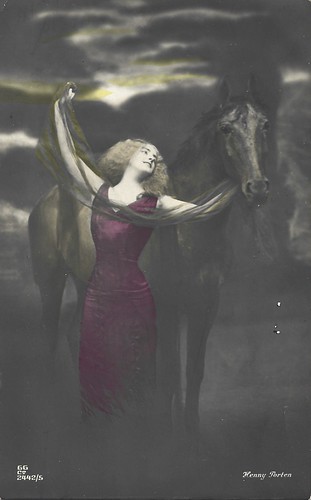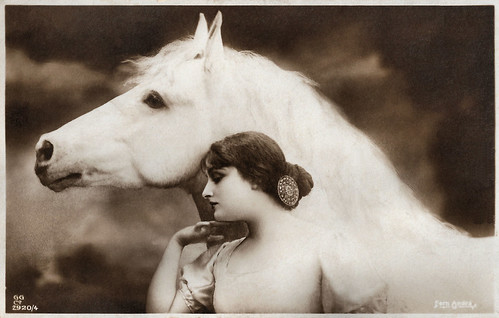
German postcard by G.G. Co. (Georg Gerlach Company, Berlin), no. 2442/5. Henny Porten.

German postcard by G.G. Co. (Georg Gerlach Company, Berlin), no. 2428/11. Henny Porten.

German postcard by Verlag Photochemie, Berlin / G.G. Co., no. 2920/4. Photo: Fern Andra Atelier. Fern Andra.

German postcard by Verlag Photochemie, Berlin / G.G. Co., no. 1885/4. Photo: Fern Andra Atelier. Fern Andra.

German postcard by Ross Verlag, no. 578. Photo: Fern Andra Atelier. Fern Andra in Der Todessprung / Um Krone und Peitsche / Crown and Whip (Georg Bluen, Fern Andra, 1919).
Wild pursuits on horseback
In early cinema, narrative connotations between women and horses were soon created. From the 1910s, women also became daredevils on horses, in the first place as amazons in circus acts.
In the Italian film L’amazzone mascherata / The Woman Who Dared (Baldassarre Negroni, 1914), Francesca Bertini played a masked amazon, who is keen to get stolen state documents back from two foreign spies. In La pantomima della morte / The Pantomime of Death (Mario Caserini, 1917), Leda Gys is a frivolous circus amazon who gets her comeuppance when she has driven a man to death: she is killed during her circus act.
In Chaplin’s film The Circus (Charles Chaplin, 1928), Merna Kennedy plays a young amazon and Charlie’s love interest. Sometimes, women even performed wild acrobatic acts with horses, like Fern Andra. She jumped down from a high pedestal with her horse, in Der Todessprung / Um Krone und Peitsche / Crown and Whip (Georg Bluen, Fern Andra, 1919). Wild pursuits would happen on horseback, such as Linda Albertini’s in I figli di Sansonia / The Children of Samson (Filippo Costamagna, 1920).
For aristocratic or well-to-do ladies in film plots, it was standard fare to ride a horse, just like they would have done in real life. Pauline Brunius’ character rides horses in the Swedish society comedy Gyurkovicsarna / Lieutenant Tophat (John W. Brunius, 1920).
Likewise, Mae Murray uses horse riding as part of her new life as a super-rich woman, who, after her inheritance, has become The Merry Widow (Erich von Stroheim, 1925). Expressing control and power, women may drive a horse and cart themselves, like a tilbury, or, when too chic for this, men would drive the carts for them, as in the Italian film L’ombra / The Shadow (Mario Almirante, 1923).

Spanish collector card by Reclam Film, Mallorca, no. 1 of 6. Photo: Celio Film. Francesca Bertini and Alberto Collo in L'amazzone mascherata / The Woman Who Dared (Baldassarre Negroni, 1914). The Spanish release title was La Amazona disfrazada.

Spanish collector card by Edics. y Publics. de Arte L. Planas, Barcelona, no. 3. Leda Gys and Mario Bonnard (in the background) in La pantomima della morte / The Pantomime of Death (Mario Caserini, 1915). The Spanish release title was La pantomima de la muerte.

German postcard by Ross Verlag, no. 580. Photo: Fern Andra Atelier. Fern Andra in Der Todessprung / Um Krone und Peitsche / Crown and Whip (Georg Bluen, Fern Andra, 1919).

Swedish postcard by Förlag Nordisk Konst, Stockholm, no. 1096/6. Photo: Skandia Film. Gösta Ekman and Pauline Brunius in the comedy Gyurkovicsarna / Lieutenant Tophat (John W. Brunius, 1920).

Italian postcard by Ed. Ballerini & Fratini, Firenze. Photo: Alba Film. Italia Almirante Manzini in L'ombra / The Shadow (Mario Almirante, 1923). Caption: Morning strolls.

German postcard by Ross Verlag, Berlin, no. 1296/1, 1927-1928. Photo: Loew-Metro-Goldwyn. Mae Murray in The Merry Widow (Erich von Stroheim, 1925). The film was released in Europe from 1926 onward.

German postcard by Ross Verlag, no. 2090/1, 1928-1929. Photo: United Artists. Merna Kennedy in The Circus (Charles Chaplin, 1928).
Riding attire as an expression of modernity
Sometimes young women dressed as men, and thus, (sometimes wild) horse riding was part of their daily life. In the Dutch film Majoor Frans (Maurits Binger, 1916), Annie Bos played a girl raised as a boy by her father, a high-ranking military officer.
Riding attire was considered quite fashionable, and thus many female film stars, particularly in Germany in the 1920s, posed in riding jackets, bowler hats and whips, as an expression of modernity. Thus, we can see stars of Weimar cinema like Cilly Feindt, Elisabeth Pinajeff and Marcella Albani in riding gear.
Of course, a typical type is the wild cowgirl, connected to the Western, often breaking rules of strict morality and decency, and opposed to the stern settlers, the prostitutes in the brothels, or the well-dressed woman of the city. A good example is Vilma Banky’s part in The Winning of Barbara Worth (Henry King, 1926). Right from the start of the film, she shows she can ride a wild horse and tame it, even if Ronald Colman comes to help when necessary.
Other examples are Mary Brian in The Virginian (Victor Fleming, 1929). Another recurring trope is the horse racing environment, such as Marion Nixon in Sporting Life (Maurice Tourneur, 1925), a film that was presented in Italy at the time as Donne e cavalli (Women and Horses). Nixon played the daughter of a horse trainer.
Yet, female jockeys also occur in silent cinema, e.g. in the American film The Whip (Maurice Tourneur, 1917), with Alma Hanlon as female jockey, and the Australian film Silk and Saddles (John Wells, 1921), retitled Queen of the Turf in the US, and starring Agnes Vernon as a daring sportswoman.

German postcard by Verlag Ross, Berlin, no. 840/3, 1925-1926. Photo: Alex Binder / Albani-Film. Marcella Albani.

German postcard by Verlag Ross, Berlin, no. 1679/1, 1927-1928. Photo: Alex Binder, Berlin. Elisabeth Pinajeff.

German postcard by Ross Verlag, no. 1961/1, 1927-1928. Photo: Becker & Maass, Berlin. Cilly Feindt.

German postcard by Verlag Ross, Berlin, no. 1795/3, 1927-1928. Photo: United Artists. Ronald Colman and Vilma Banky in The Winning of Barbara Worth (Henry King, 1926).

German postcard by Ross Verlag, no. 4673/1, 1929-1930. Photo: Paramount. Mary Brian in The Virginian (Victor Fleming, 1929).

Italian postcard by G.B. Falci Editore, Milano, no. 506. Marion Nixon in Sporting Life (Maurice Tourneur, 1925).

German Postcard by Ross Verlag, no. 5745/1, 1930-1931. Photo: Paramount. Lily Damita in Fighting Caravans (Otto Brower, David Burton, 1931).
Text and postcards: Ivo Blom. For more postcards, check out our Flickr album 'Women and horses' or our post 'The White Horse'.
No comments:
Post a Comment